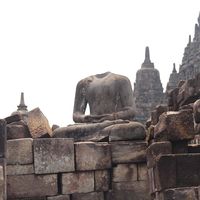Buddhist Hanging Scroll from Heungguksa Temple | Korea
 The National Museum of Korea presents a thematic exhibition entitled 'Encounter with Amitāyus in Sukhāvatī, Buddhist Hanging Scroll at Hengguksa Temple', which displays a large hanging scroll once used for Buddhist outdoor rituals.
This display is part of the regular series of the Buddhist painting exhibition held in the National Museum of Korea. Since 2006, this is the eighth installment in the museum's ongoing series of exhibitions of banner paintings used for Buddhist rituals.
The banner painting (Gwaebul) featured in this exhibition was painted in 1902 for Heungguksa Temple in Goyang-gun, Gyeonggi Province. It was commissioned and donated by Empress Sunheon, the second wife of Emperor Gojong, the king of the Joseon Dynasty (1392~1910). Empress Sunheon, a former court woman of Empress Myeongseong, became the Empress herself after Empress Myeongseong’s death. Empress Sunheon dedicated the scroll to Heungguksa Temple as an offering for the well-being of the royal family: Emperor Gojong, herself, the crown prince, the crown prince’s consort, and Prince Imperial Yeongchin. The gwaebul also signifies Empress Sunheon’s wish to meet the “Buddha of Infinite Life” in the Western Paradise.
Buddha of Infinite Life is another name for Amitabha Buddha, a celestial Buddha who is believed to reside in the Western Paradise or Pure Land. “Amitabha” may be translated as “infinite light” and is believed to grant eternal life; as such, Amitabha Buddha is sometimes known as either the Buddha of Infinite Light or the Buddha of Infinite Life. Notably, this gwaebul was painted in the early twentieth century, a period of significant historical and social turmoil in Korea. At that time, when calling on the Buddha of the Western Paradise to help them overcome the suffering and strife of their everyday lives, the Korean people often preferred the title of the Buddha of Infinite Life, rather than Amitabha Buddha.
The National Museum of Korea presents a thematic exhibition entitled 'Encounter with Amitāyus in Sukhāvatī, Buddhist Hanging Scroll at Hengguksa Temple', which displays a large hanging scroll once used for Buddhist outdoor rituals.
This display is part of the regular series of the Buddhist painting exhibition held in the National Museum of Korea. Since 2006, this is the eighth installment in the museum's ongoing series of exhibitions of banner paintings used for Buddhist rituals.
The banner painting (Gwaebul) featured in this exhibition was painted in 1902 for Heungguksa Temple in Goyang-gun, Gyeonggi Province. It was commissioned and donated by Empress Sunheon, the second wife of Emperor Gojong, the king of the Joseon Dynasty (1392~1910). Empress Sunheon, a former court woman of Empress Myeongseong, became the Empress herself after Empress Myeongseong’s death. Empress Sunheon dedicated the scroll to Heungguksa Temple as an offering for the well-being of the royal family: Emperor Gojong, herself, the crown prince, the crown prince’s consort, and Prince Imperial Yeongchin. The gwaebul also signifies Empress Sunheon’s wish to meet the “Buddha of Infinite Life” in the Western Paradise.
Buddha of Infinite Life is another name for Amitabha Buddha, a celestial Buddha who is believed to reside in the Western Paradise or Pure Land. “Amitabha” may be translated as “infinite light” and is believed to grant eternal life; as such, Amitabha Buddha is sometimes known as either the Buddha of Infinite Light or the Buddha of Infinite Life. Notably, this gwaebul was painted in the early twentieth century, a period of significant historical and social turmoil in Korea. At that time, when calling on the Buddha of the Western Paradise to help them overcome the suffering and strife of their everyday lives, the Korean people often preferred the title of the Buddha of Infinite Life, rather than Amitabha Buddha.
View all Asia-Europe Museum Network (ASEMUS) members in Korea
Similar content
12 Feb 2016 - 14 Aug 2016
from - to
17 Dec 2011 - 03 Jun 2012
from - to
07 Oct 2021 - 11 Nov 2021
posted on
04 Sep 2012
from - to
26 Oct 2013 - 19 Jan 2014

